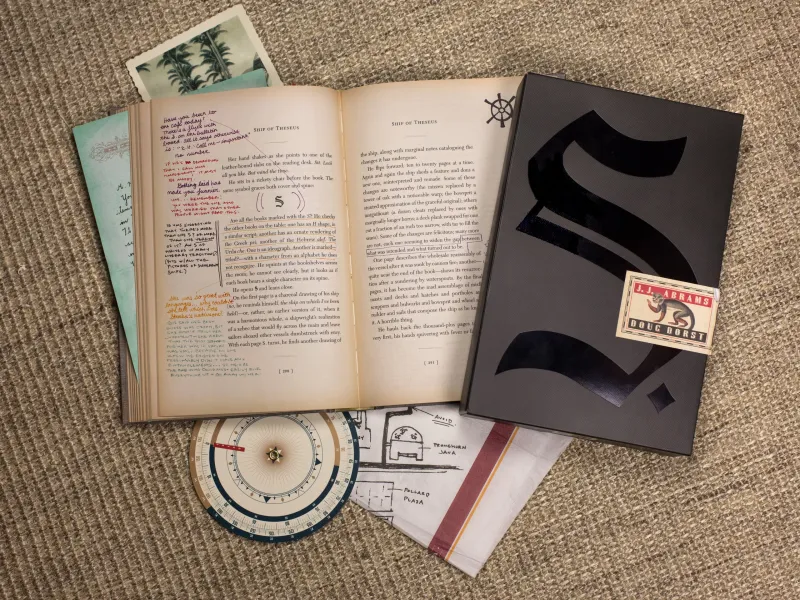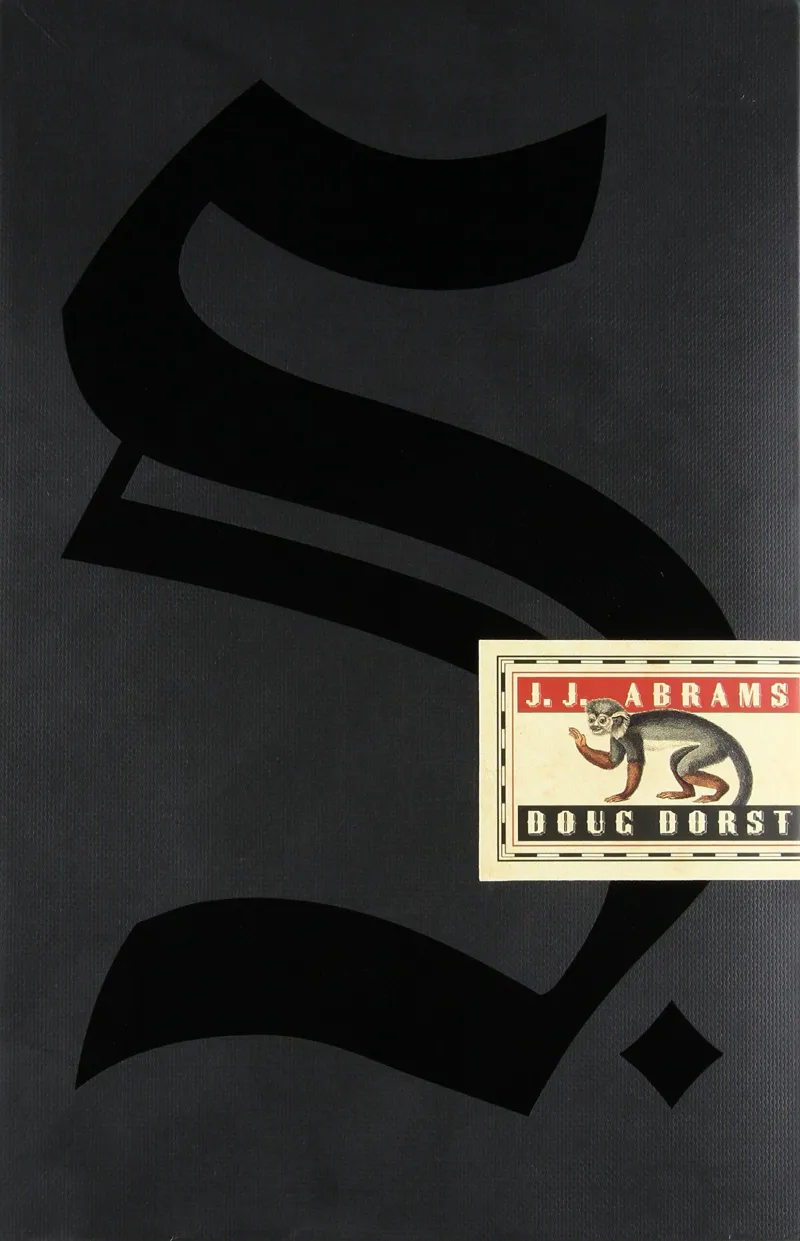An overview of
S.
by Doug Dorst & J.J. Abrams
2.Mulholland Booksa
a.2013
S. summarized (in two sentences or less)
In S., two readers, Eric and Jen, discover an old library book called Ship of Theseus and begin exchanging notes in the margins, unraveling a multi-layered mystery that spans decades and continents. As they dig deeper, their own lives start to intertwine and mirror the enigmatic story within the book, blurring the lines between fiction and reality.
S. Trivia and/or (Un)fun Facts
Multi-Media Experience: The book comes with 22 additional items like postcards, newspaper clippings, and handwritten notes, making it more than just a book—it's an interactive experience.
Collaborative Genius: The project is a collaboration between J.J. Abrams, known for his work in film and television, and Doug Dorst, an accomplished novelist and short story writer.
Inspiration: The concept for S. was inspired by J.J. Abrams' real-life experience of finding a book left behind in an airport, complete with annotations from its previous owner.
Why S. Is Challenging
Multiple Layers: You're not just reading one story; you're juggling multiple narratives at once—the book within the book, and the margin notes between Eric and Jen.
Interactive Elements: The book comes with physical items like postcards and newspaper clippings, which you'll need to examine to fully grasp the story.
Non-Linear: The margin notes aren't always sequential, and you'll often find yourself flipping back and forth between pages to connect the dots.
Puzzle Pieces: The book is filled with codes, ciphers, and hidden messages that require some detective work to decipher.
Emotional Complexity: Beyond the intellectual challenges, the book delves into deep emotional and philosophical themes that require some pondering.
Why S. Is Worth Reading
Beyond its interactive wizardry, the coolest thing has to be the way it plays with the concept of authorship and ownership of a story. You've got a book within a book, and then you've got Eric and Jen annotating the margins, essentially becoming co-authors. It's a meta-commentary on how stories are shaped not just by their creators but also by their readers. It's like a narrative Russian nesting doll that keeps you questioning what's real and what's fiction.
Who S. Is For
Mystery Buffs: If you love a good whodunit or treasure hunt, this book's intricate puzzles and codes will keep you hooked.
Metafiction Maniacs: If you're into stories that are self-aware, that break the fourth wall, and make you question the nature of storytelling itself, welcome aboard.
Detail Detectives: If you have an eye for detail and love digging into the nitty-gritty, the book's complex layers offer a rich playground.
Romantic Souls: If you're a sucker for a love story, especially one that unfolds in an unconventional way, you'll be rooting for Eric and Jen.
Literary Adventurers: If you're not afraid to venture into unconventional storytelling formats and experimental literature, this is your next expedition.
Patient Readers: If you don't mind taking your time to unravel a complex narrative and piece together clues, you'll find this book rewarding.
What S. Looks Like

S. is a book within a book within a book. Plus postcards.
How to Read S.
Multiple Passes: Consider reading "Ship of Theseus" first, then go back for Eric and Jen's margin notes. Or, if you're feeling brave, juggle both at once.
Take Notes: With so many layers, it's easy to lose track. Jot down your thoughts, questions, or any clues you find along the way.
Bookmark Liberally: Use sticky notes or bookmarks to flag important pages or clues. Trust me, you'll be flipping back and forth a lot.
Decode as You Go: The book has its fair share of codes and ciphers. Try to crack them as you go along; they often add another layer to the story.
Engage with the Extras: Don't ignore the postcards, newspaper clippings, and other items tucked into the book. They're part of the experience.
Mindset Matters: This isn't a casual read. Make sure you're in a space—mentally and physically—where you can focus and reflect.
Take Your Time: Don't rush. The book is dense and packed with details that are easy to miss if you're skimming.
Discussion Questions about S.
S. Research Prompts for Postdocs:
-
Metafiction and Authorship: How does S. challenge traditional notions of authorship through its multi-layered narrative and reader annotations?
Intertextuality: What role does intertextuality play in "S.," especially considering the book within a book and the various real-world references?
Epistemology of Text: How does the book engage with theories of knowledge, particularly in the context of deciphering what is 'real' or 'true' within its multiple narratives?
Reader Agency: How does the book's interactive format affect the reader's agency in constructing the narrative, and does this constitute a form of co-creation?
Semiotics and Multimodality: How do the various modes of text, handwriting, and physical ephemera contribute to the semiotic richness of the work?
Narrative Ethics: Given its complex structure and the personal stories of Eric and Jen, how does S. navigate the ethical complexities of representing real and fictional lives?
Cultural and Historical Context: How does S. reflect or critique the cultural and historical context of its creation, particularly in the realm of literature and interactive media?
The Materiality of Text: Given its unique physical form and interactive elements, how does S. contribute to discussions about the materiality of literature and its impact on interpretation?
Psychological Realism: How does the book's structure and style engage with psychological theories about how humans experience and recall events?
Postmodern Identity: How does S. explore themes of identity, both individual and collective, in a postmodern context?
S. Conversation Starters for Normal People:
- Multiple Narratives: How does juggling the story of "Ship of Theseus" with Eric and Jen's margin notes affect your understanding of the overall plot?
Interactive Elements: How do the physical items like postcards and newspaper clippings contribute to your engagement with the story?
Themes and Emotions: Despite its experimental form, the book tackles heavy themes like love, identity, and the search for truth. How does the structure enhance or detract from these emotional elements?
Reader's Role: How does the book's unique format change your role as a reader? Do you feel more active, engaged, or perhaps even disoriented?
Comparative Analysis: How does S. compare to other experimental or non-linear narratives you've encountered? What sets it apart?
Questions about S. that you can ask your dog:
- Why Do You Think Eric and Jen Write Notes to Each Other?: What do you think they want to find out by writing in the book?
How Do You Think the Ship of Theseus Makes Eric and Jen Feel?: Do you think they feel excited, scared, or something else when they read about it?
What Do Eric and Jen Learn From Each Other?: How do you think they help each other understand the book better?
The Most Amusing S. Review I Can Find
it's like ready player one but for the bad kind of nerd (the boring reading footnotes kind not the fun video game kind)
★☆☆☆☆
—Caleb via Goodreads
—Caleb via Goodreads
